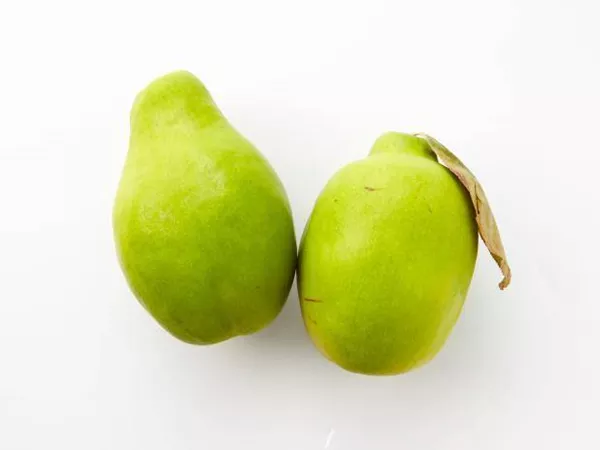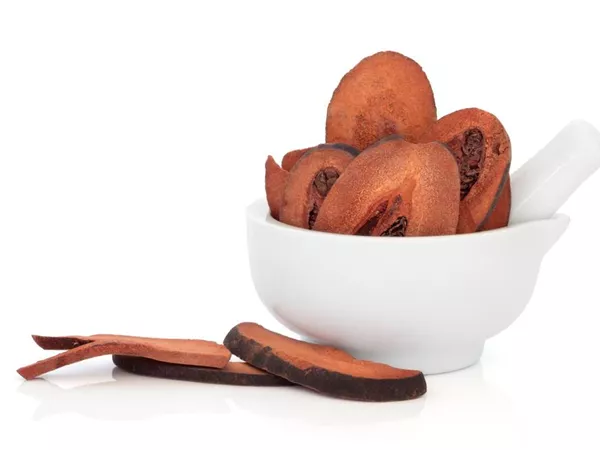Mu Gua
Mu Gua
English: Flowering quince
Chinese: 木瓜
Parts used: Dried nearly-ripe fruit
TCM category: Herbs that dispel Wind and DampnessHerbs that warm the Interior and/or expel Cold
TCM nature: Warm
TCM taste(s): Sour
Scientific name: Pseudocydonia sinensis
Other names: Chinese quince, Mogwa, Mokgwa, Karin, Chaenomeles speciosa
Use of Mu Gua (flowering quince) in TCM
Please note that you should never self-prescribe TCM ingredients. A TCM ingredient is almost never eaten on its own but as part of a formula containing several ingredients that act together. Please consult a professional TCM practitioner, they will be best able to guide you.
Preparation: Wash, steam thoroughly, slice and dry.
Dosage: 1 or 2 fruits
Main actions according to TCM*: Relaxes the sinews by increasing the flow of both Blood and Qi. Assists the function of the Stomach and expels Dampness. Facilitate lactation.
Primary conditions or symptoms for which Mu Gua may be prescribed by TCM doctors*: Rheumatoid arthritis Systremma Heatstroke Diarrhea Edema
Contraindications*: Should not be used by those with Yin Deficiency. It should also be avoided in Exterior conditions.
Common TCM formulas in which Mu Gua is used*
Bu Gan Tang
Source date: 1742 AD
Number of ingredients: 7 herbs
Formula key actions: Tonifies and regulates the Blood. Nourishes the Liver Yin.
Conditions targeted*: PhotophobiaAnemia and others
Mu Gua is an assistant ingredient in Bu Gan Tang. This means that it either serves to reinforces the effect of other ingredients or it moderates their toxicity.
In Bu Gan Tang, Mu Gua relaxes the sinews by increasing the flow of both Blood and Qi.
Key TCM concepts behind Mu Gua's properties
In Traditional Chinese Medicine (TCM), Mu Gua belongs to the 'Herbs that dispel Wind and Dampness' category. These herbs typically help treat what's called 'bi pain' (i.e. painful obstruction) in TCM. This roughly corresponds to arthritic and rheumatic conditions with pain, stiffness and numbness of the bones, joints and muscles.
Furthermore Mu Gua is Warm in nature. This means that Mu Gua tends to help people who have too much 'Cold' in their body, although with less effect than a plant that would be Hot in nature. Balance between Yin and Yang is a key health concept in TCM. Those who have too much Cold in their body are said to either have a Yin Excess (because Yin is Cold in nature) or a Yang Deficiency (Yang is Hot in Nature). Depending on your condition Mu Gua can help restore a harmonious balance between Yin and Yang.
Mu Gua also tastes Sour. The so-called 'Five Phases' theory in Chinese Medicine states that the taste of TCM ingredients is a key determinant of their action in the body. Sour ingredients like Mu Gua helps with digestion and restrain abnormal discharges of Fluids from the body, such as diarrhea or heavy sweating.
The tastes of ingredients in TCM also determine what Organs and Meridians they target. As such Mu Gua is thought to target the Liver and the Spleen. In TCM the Liver is often referred as the body's "general" because it is in charge of regulating the movements of Qi and the Body Fluids. It also takes a leading role in balancing our emotions. The Spleen on the other hand assists with digestion, Blood coagulation and Fluids metabolism in the body.
Research on Mu Gua
Extracts of phytochemicals in the flowering quince have antioxidant and antiviral properties. 1.
Sources:
1. Hamauzu, Yasunori, et al. "Reddish coloration of Chinese quince (Pseudocydonia sinensis) procyanidins during heat treatment and effect on antioxidant and antiinfluenza viral activities." Journal of agricultural and food chemistry 55.4 (2007): 1221-1226.
Use of Mu Gua as food
Mu Gua is also eaten as food. It is used as an ingredient in dishes such as Chinese quince and apple pie.





